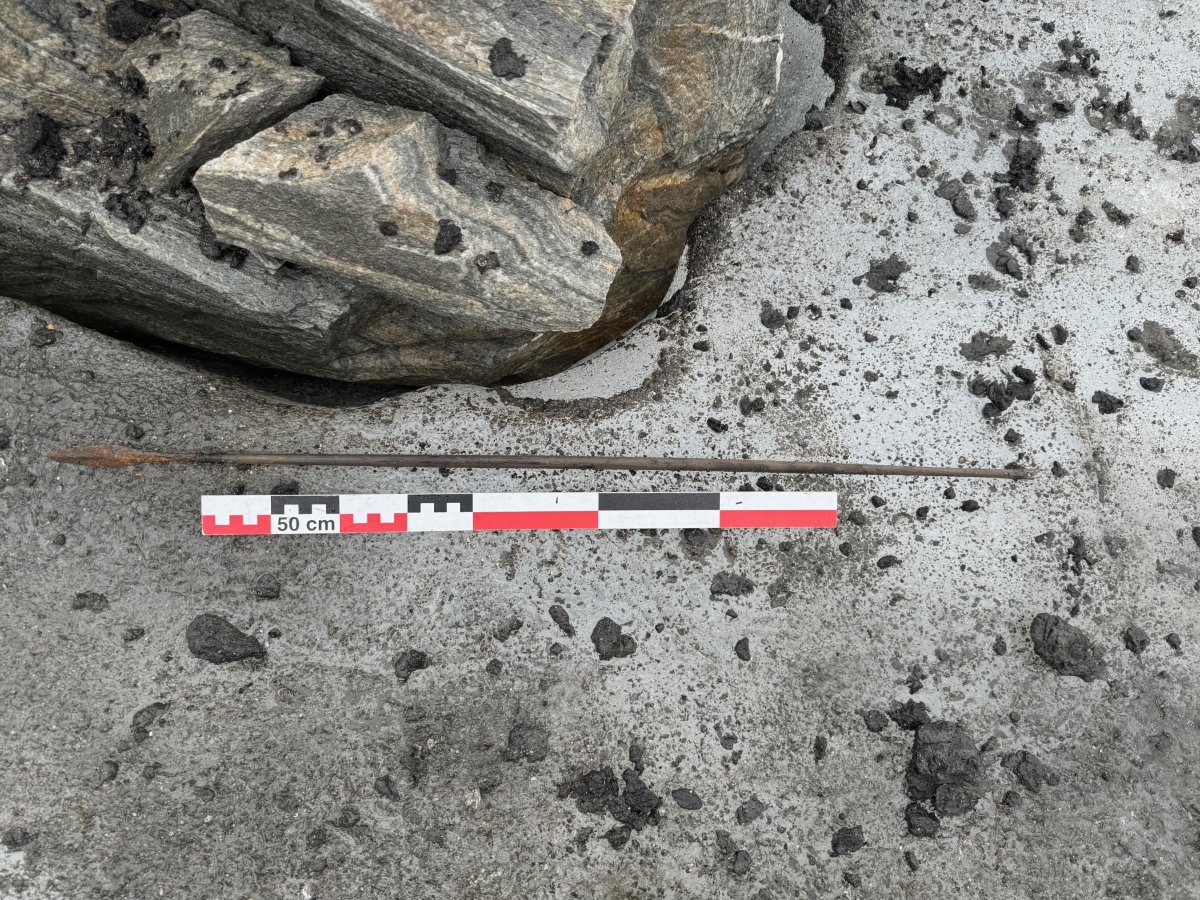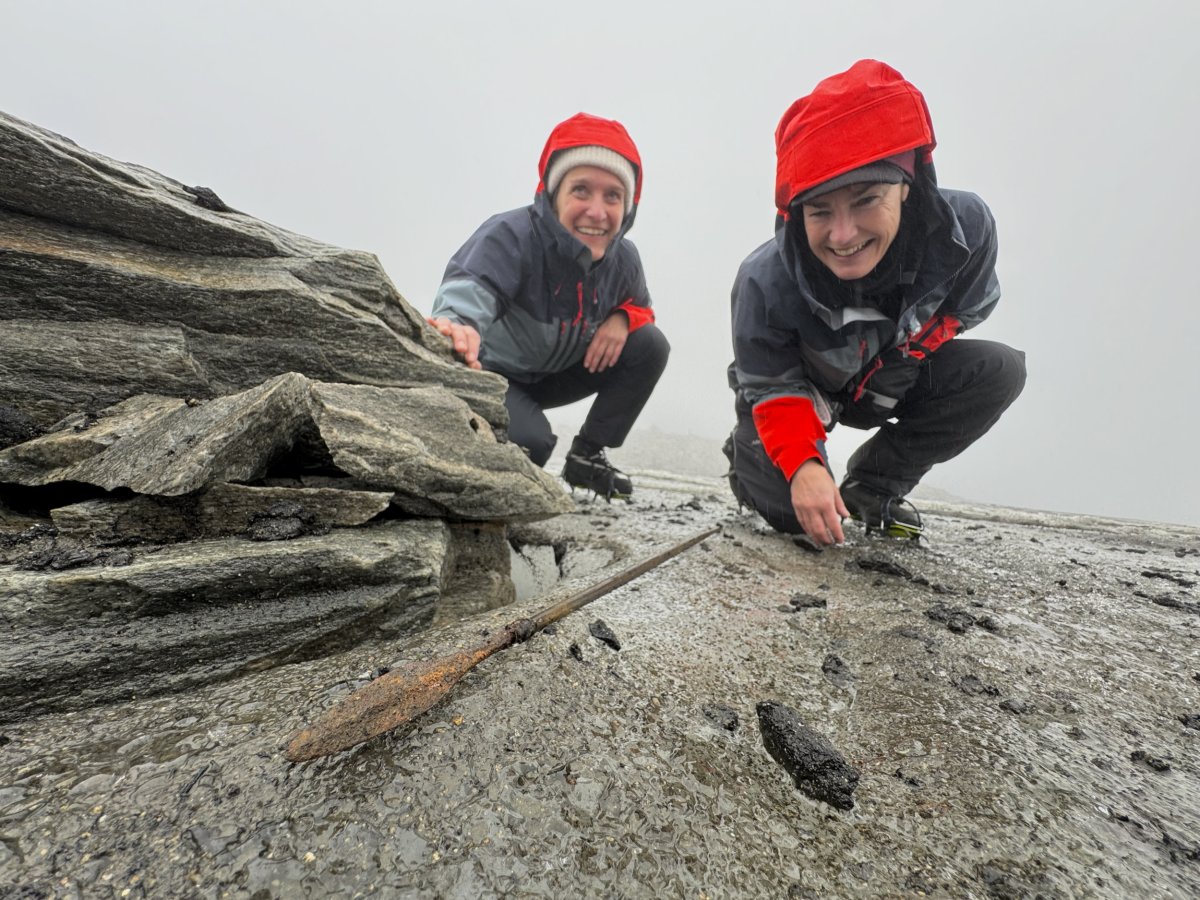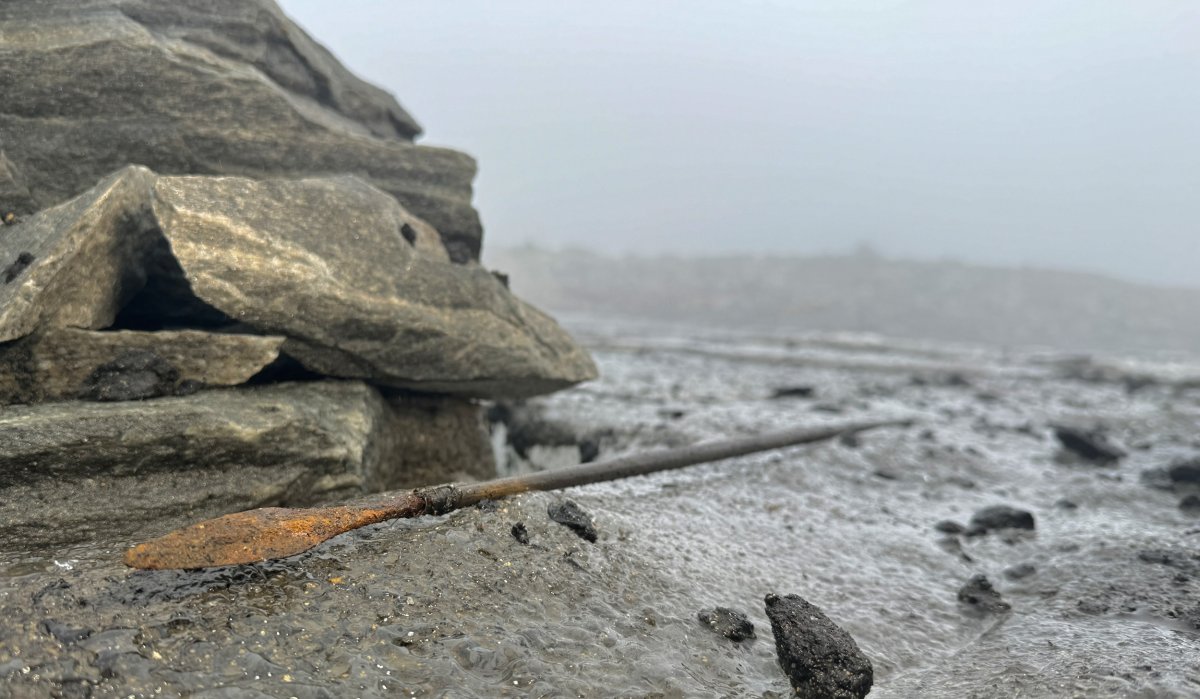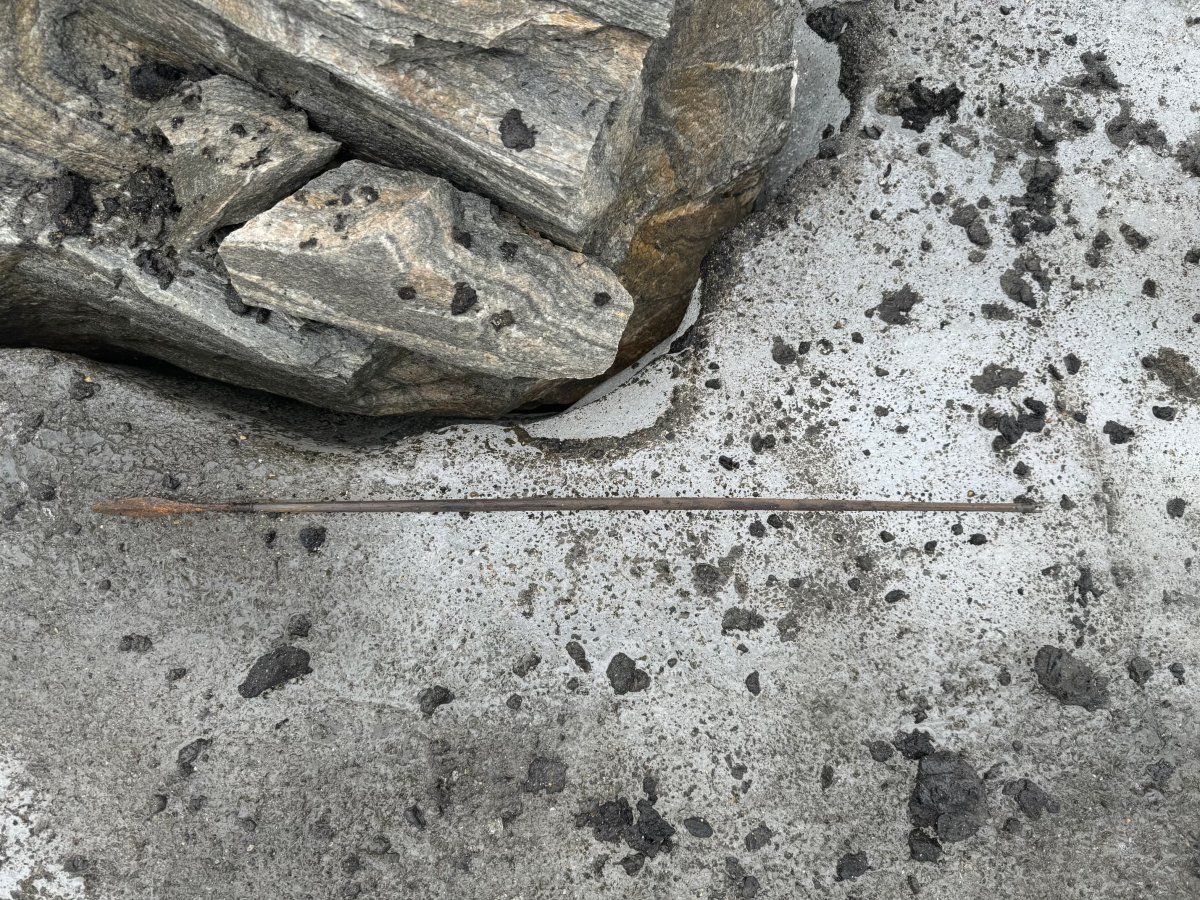A tool dating back around 1,300 years that's believed to have been used for hunting was found on the surface of glacial ice in Norway on Wednesday.
The artifact was discovered on the Lendbreen ice patch in Innlandet county by a team of archaeologists from Secrets of the Ice, a program that specializes in the archaeology of glaciers and ice patches.
Glacial archaeologist Lars Holger Pilø, who is the co-director of Secrets of the Ice, told Newsweek: "Lendbreen is a 'lost' mountain pass site, which also contains remains from reindeer hunting, like the arrow."
Images of the arrow were shared in viral posts on X, formerly Twitter, by Secret of the Ice as well as on Reddit by Pilø under the username ScaringStick. A couple of more images that Pilø shared with Newsweek provide additional views of the arrow.

An image of the arrow shared with Newsweek, which was discovered on the Lendbreen ice patch in the county of Innlandet. Espen Finstad, Secretsoftheice.com
Pilø, who is also affiliated with the Innlandet County Council Department of Cultural Heritage, explained: "The arrow in question is incredibly well-preserved even for ice finds. It was found lying on the ice, which is normally a sign that the melt has reached layers previously untouched by melt. So, this arrow has probably not been out of the ice since it was lost 1,300 years ago. It is frozen in time in a literal sense."
According to Pilø, the arrow can be dated by the shape of its iron arrowhead, which is a known type, found in graves from around A.D. 700, which is older than the Viking Age, a period spanning from A.D. 800 to A.D. 1050.

An image of the 1,300-year-old arrow shared with Newsweek. The old hunting tool was discovered by a team of archaeologists from the Secrets of the Ice program of Norway's Department of Cultural Heritage. Espen Finstad, Secretsoftheice.com
"We have also found a few arrows with a similar arrowhead on a few occasions, which have come out with the same radiocarbon date. Though none were so well-preserved as the one from yesterday [Wednesday], which is in an exceptional condition," he noted.
Pilø and his team have been rescuing finds from the ice in Innlandet county since 2006, as part of a collaboration between the Innlandet County Council and the Museum of Cultural History in Oslo. They now have 69 ice sites and over 4,000 archaeological finds from the ice in the county alone.
In August, researchers from Secrets of the Ice found objects known as "scaring stick" flags in Breheimen National Park in a mountainous region of Norway, which were believed to be around 1,500 years old. The team discovered one complete flag and a broken one around 65 feet away.

The arrow can be dated by the shape of its iron head, which is a known type found in graves from around A.D. 700, one of the archaeologists from the team behind its finding told... More Espen Finstad, Secretsoftheice.com
"The emergence of archaeological finds from the retreating ice is directly linked to global warming," Pilø said.
According to the International Energy Agency (IEA), the average annual temperature in Norway has risen by 1.1 degrees Celsius since 1900 and warming is expected to continue in the future.
"Warming has been strongest during the spring and in northern parts of the country. The islands of Svalbard, situated further north, have experienced a higher warming rate than mainland Norway," the IEA said.
Climate projections show that the country's average temperature is likely to be around 4.5 degrees Celsius higher by the end of the century than it was in the period from 1971 to 2000.
While the increase in temperature is expected to impact all seasons, it will be stronger in the winter than the summer, which means that "the growing season"—the number of days with an average temperature above 5 degrees Celsius—is "likely to lengthen considerably by the end of the century," the IEA said.

An "incredibly well-preserved" 1,300-year-old arrow was discovered Wednesday in a "lost" mountain site in Norway. Espen Finstad, Secretsoftheice.com
SOURCE:
https://www.newsweek.com/archaeolog...arrow-hunting-tool-artifact-discovery-1949849
The artifact was discovered on the Lendbreen ice patch in Innlandet county by a team of archaeologists from Secrets of the Ice, a program that specializes in the archaeology of glaciers and ice patches.
Glacial archaeologist Lars Holger Pilø, who is the co-director of Secrets of the Ice, told Newsweek: "Lendbreen is a 'lost' mountain pass site, which also contains remains from reindeer hunting, like the arrow."
Images of the arrow were shared in viral posts on X, formerly Twitter, by Secret of the Ice as well as on Reddit by Pilø under the username ScaringStick. A couple of more images that Pilø shared with Newsweek provide additional views of the arrow.

An image of the arrow shared with Newsweek, which was discovered on the Lendbreen ice patch in the county of Innlandet. Espen Finstad, Secretsoftheice.com
Pilø, who is also affiliated with the Innlandet County Council Department of Cultural Heritage, explained: "The arrow in question is incredibly well-preserved even for ice finds. It was found lying on the ice, which is normally a sign that the melt has reached layers previously untouched by melt. So, this arrow has probably not been out of the ice since it was lost 1,300 years ago. It is frozen in time in a literal sense."
According to Pilø, the arrow can be dated by the shape of its iron arrowhead, which is a known type, found in graves from around A.D. 700, which is older than the Viking Age, a period spanning from A.D. 800 to A.D. 1050.

An image of the 1,300-year-old arrow shared with Newsweek. The old hunting tool was discovered by a team of archaeologists from the Secrets of the Ice program of Norway's Department of Cultural Heritage. Espen Finstad, Secretsoftheice.com
"We have also found a few arrows with a similar arrowhead on a few occasions, which have come out with the same radiocarbon date. Though none were so well-preserved as the one from yesterday [Wednesday], which is in an exceptional condition," he noted.
Pilø and his team have been rescuing finds from the ice in Innlandet county since 2006, as part of a collaboration between the Innlandet County Council and the Museum of Cultural History in Oslo. They now have 69 ice sites and over 4,000 archaeological finds from the ice in the county alone.
In August, researchers from Secrets of the Ice found objects known as "scaring stick" flags in Breheimen National Park in a mountainous region of Norway, which were believed to be around 1,500 years old. The team discovered one complete flag and a broken one around 65 feet away.

The arrow can be dated by the shape of its iron head, which is a known type found in graves from around A.D. 700, one of the archaeologists from the team behind its finding told... More Espen Finstad, Secretsoftheice.com
"The emergence of archaeological finds from the retreating ice is directly linked to global warming," Pilø said.
According to the International Energy Agency (IEA), the average annual temperature in Norway has risen by 1.1 degrees Celsius since 1900 and warming is expected to continue in the future.
"Warming has been strongest during the spring and in northern parts of the country. The islands of Svalbard, situated further north, have experienced a higher warming rate than mainland Norway," the IEA said.
Climate projections show that the country's average temperature is likely to be around 4.5 degrees Celsius higher by the end of the century than it was in the period from 1971 to 2000.
While the increase in temperature is expected to impact all seasons, it will be stronger in the winter than the summer, which means that "the growing season"—the number of days with an average temperature above 5 degrees Celsius—is "likely to lengthen considerably by the end of the century," the IEA said.

An "incredibly well-preserved" 1,300-year-old arrow was discovered Wednesday in a "lost" mountain site in Norway. Espen Finstad, Secretsoftheice.com
SOURCE:
https://www.newsweek.com/archaeolog...arrow-hunting-tool-artifact-discovery-1949849



 wonderful pictures
wonderful pictures 

